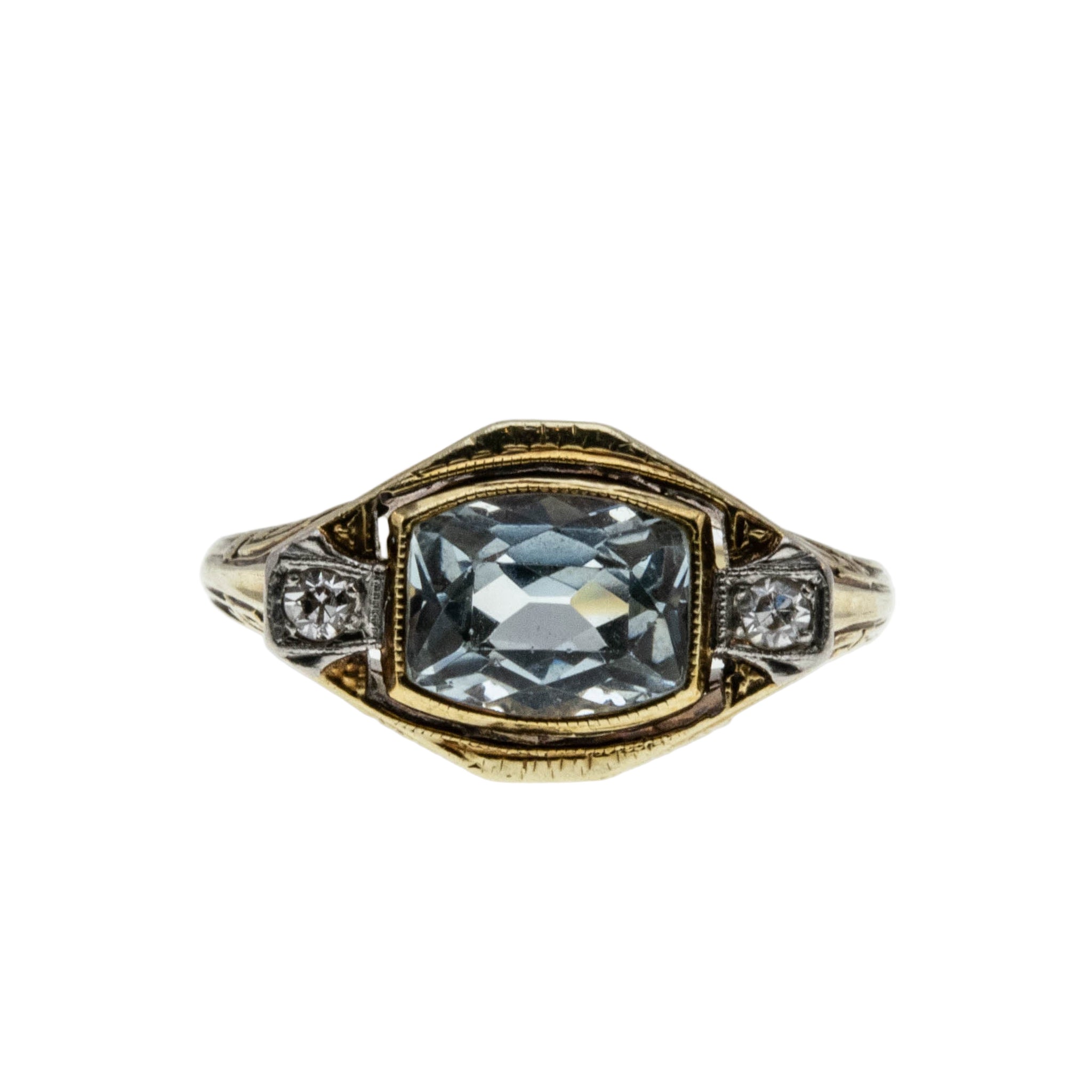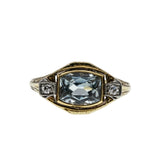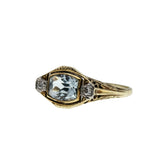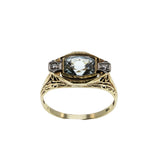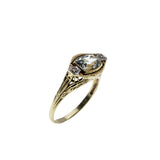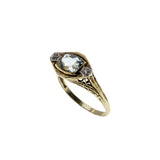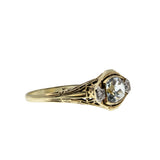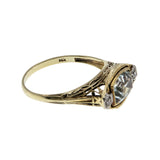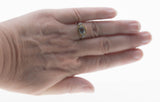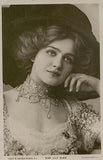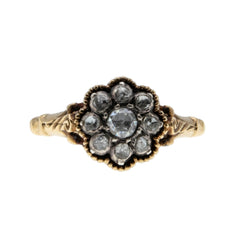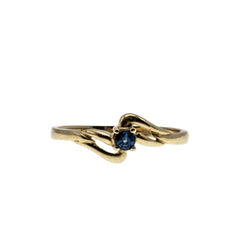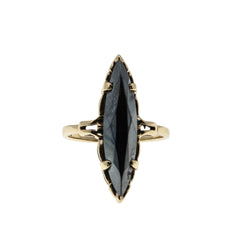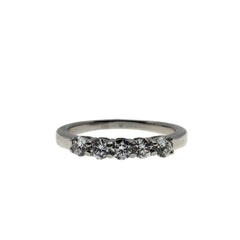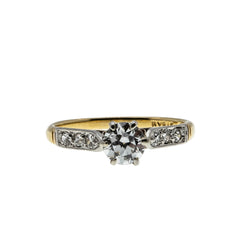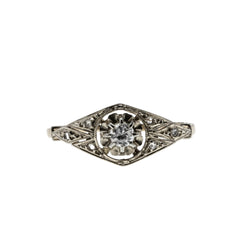Blue Horizon - Edwardian European 14K Gold Natural Aquamarine & 'Old European cut' Diamond Filigree Ring (EDR096)
Rarities Antique Jewelry
Blue Horizon - Edwardian European 14K Gold Natural Aquamarine & 'Old European Cut' Diamond Filigree Ring. This exquisite ring is crafted from 14K yellow gold, hallmarked 14K. This ring features one natural cushion cut aquamarine, two natural 'Old European Cut 'diamonds, Edwardian era styling, and high quality craftsmanship. This ring is expertly bezel set with a beautiful blue aquamarine, displaying bluish/greenish/grey hues. The precious aquamarine is adorned by a glowing diamond on each side, which adds even more sparkle to the ring. The beautiful gemstones are surrounded by delicate milgrain detail, engravings, and a sea of filigree, which can be seem on top and the profile of the exquisite gallery. The shank is smooth, and polished, which allows for easy sizing and a comfortable fit. This rare Edwardian ring would make a unique engagement ring, gift, or addition to any fine jewelry collection.
Comments: Wonderful unusual rare example. Aquamarine is completely free of any inclusions. Beautiful dreamy blue colour.
Note: Contemporary appraisals do not reflect the value of antique jewelry. It is recommended that this Edwardian aquamarine and diamond ring be insured for $4500.00 CD (Tax Excluded)
History:
Comments: Wonderful craftsmanship and detail. Larger than most daisy rings. The ring has the full crisp metal purity hallmarks. Exquisite example, due to its contain and rarity.
Note: Contemporary appraisals do not reflect the value of antique Jewelry. This ring should be insured for $4000.00 CD (Tax Excluded)
History:The earliest diamonds were found in India in 4th century BC, although the youngest of these deposits were formed 900 million years ago. A majority of these early stones were transported along the network of trade routes that connected India and China, commonly known as the Silk Road.
The old European cut diamond became very popular around the late 1800s and is the predecessor of today's modern round brilliant cut. This antique cut has once again become a favorite due to the features of its cutting style and the fact that no two stones will ever be cut exactly alike.
The Old European Cut, a historic diamond cut, evolved in Europe and gained popularity between 1890 and 1930, serving as a precursor to the modern Round Brilliant cut. It's characterized by its round shape, high crown, and a small table, offering a unique charm due to being hand-cut. This cut was especially popular during the Edwardian and Art Deco periods.
Holding a piece of jewelry that contains an antique diamond feels like you’re handling ancient treasure. And for good reason! While modern diamonds are mined and cut by the millions each year, a limited number of Old Mine and Old European Cut diamonds exist in the market today.
These precursors to our modern day round brilliant cuts offer a distinct visual experience from the way their hand cut facets play with light. The facets are wider and more geometric, resulting in pops of sparkle instead of the disco ball dazzle we see in modern diamonds. They’re perfectly imperfect, and that’s what gives them their charm.
Old European cut diamonds are cut in a style developed in Europe and popular from 1890 to 1930. If you find an antique ring with a round diamond from this period, it very likely features an old European cut, often abbreviated as "OEC."
Earlier diamonds typically received what is known as an "old mine cut," while later ones were cut as the well-known modern round brilliant.
Machine cutting wasn't available when old European-cut diamonds were popular. Each one was cut by hand. While you might think this means superior craftsmanship, it really just means that each one is unique.
While the old European cut was once the most popular diamond cut, its heyday is long past. The age of these diamonds makes them antiques. Of course, this gives them an allure that modern diamonds won't have.
There simply aren't very many of them, so few appear on the market at any given time.
Most old European-cut diamonds were cut to retain more weight, rather than optimize appearance. Because of the shape of rough diamonds, the end result was a deep cut with a high crown and small table. These old diamonds also often had a flat facet instead of a tip at the culet. This not only protected the bottom from chipping but also gave them a distinctive look. You can see the culet as a circle in the middle of the table.
The higher depth and steeper crown angles allow these diamonds to show off more fire. This effect is similar to a prism creating rainbows from sunlight. As light moves through the diamond, it splits into its component colors, each curving a different amount. The colors then reflect back to your eye. Since the light travels farther in a deeper diamond, you get more fire. However, this greater depth also means that there's more light leakage in an old European cut. These diamonds simply won't look as bright as modern round brilliants. They will show less white light.
There's something perfectly-imperfect about every old Euro cut. Their hand-cut character makes each diamond one-of-a-kind. Another upside to old European cuts? They're always an ethical choice.
In 1953, GIA formally created its diamond grading system, known as the 4 C's. The 4 Cs of diamond quality are the universally recognized diamond grading system still to be used today. 1n 1955, GIA presented its first diamond grading reports, which became the hallmark of grading reports in the diamond industry. Before this time in antiquity clients did not care about diamond grading. It was based more so on the size of the diamonds ( according to budget) , style, and sentiment. This ring is a wonderful rare example of the Edwardian era, just beautiful!
Aquamarines are referenced in Ancient Greek mythology and are said to have been washed ashore after spilling from the treasure chests of Sirens. These mermaid-like creatures were famed for seducing sailors and luring them towards their peril.
Roman fishermen called the gemstone “water of the sea” and used it as protection, for safe travel by boat, and for luck in catching fish. Aquamarine was linked to the apostle St. Thomas who frequently traveled by boat. Roman physicians also used it to treat overeating and bloating.
The properties of aquamarine related to physical healing are thought to be closely connected with breathing. Sometimes referred to as the “breath stone,” aquamarine is known to alleviate sinus, lung, and respiratory problems. It is also believed to help with bronchitis, colds, hay fever, and various allergies.
Aquamarine is most often light in tone and ranges from greenish blue to blue-green. The color is usually more intense in larger stones, and darker blue stones are very valuable. This gemstone is mined mainly in Brazil, but it is also found in Nigeria, Madagascar, Zambia, Pakistan, and Mozambique.
Gold was generally used for a couple thousand years solely to create things such as jewelry and idols for worship. This was until around 1500 BC when the ancient empire of Egypt, which benefited greatly from its gold-bearing region, Nubia, made gold the first official medium of exchange for international trade.
The Edwardian era corresponds to the reign of King Edward VII in Great Britain, whose short-lived governance (1901-1910) followed Victoria's long reign and preceded the modern House of Windsor in England. The "Edwardian" style broadly encompasses the years of 1901 through to 1919.
Measurements: Face of the Ring 15.50 mm x 10.00 mm
Stone Size: Aquamarine (Cushion Shape Mixed Cut) 1.50 carats Clarity: F (Free of inclusions) Colour Tone - Light, even disbursement of light. Diamonds .04 Carats Clarity I1 Colour GH grams
Weight: 3.30 grams
Ring Size: 8 1/2
Condition: Excellent Note: Amazing condition.
Origin: Europe
Date: Circa 1910

